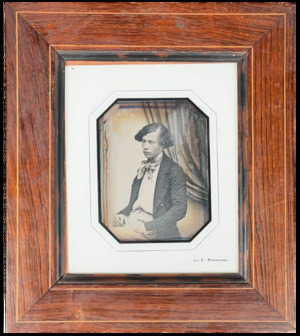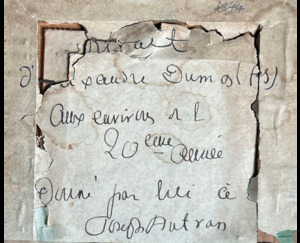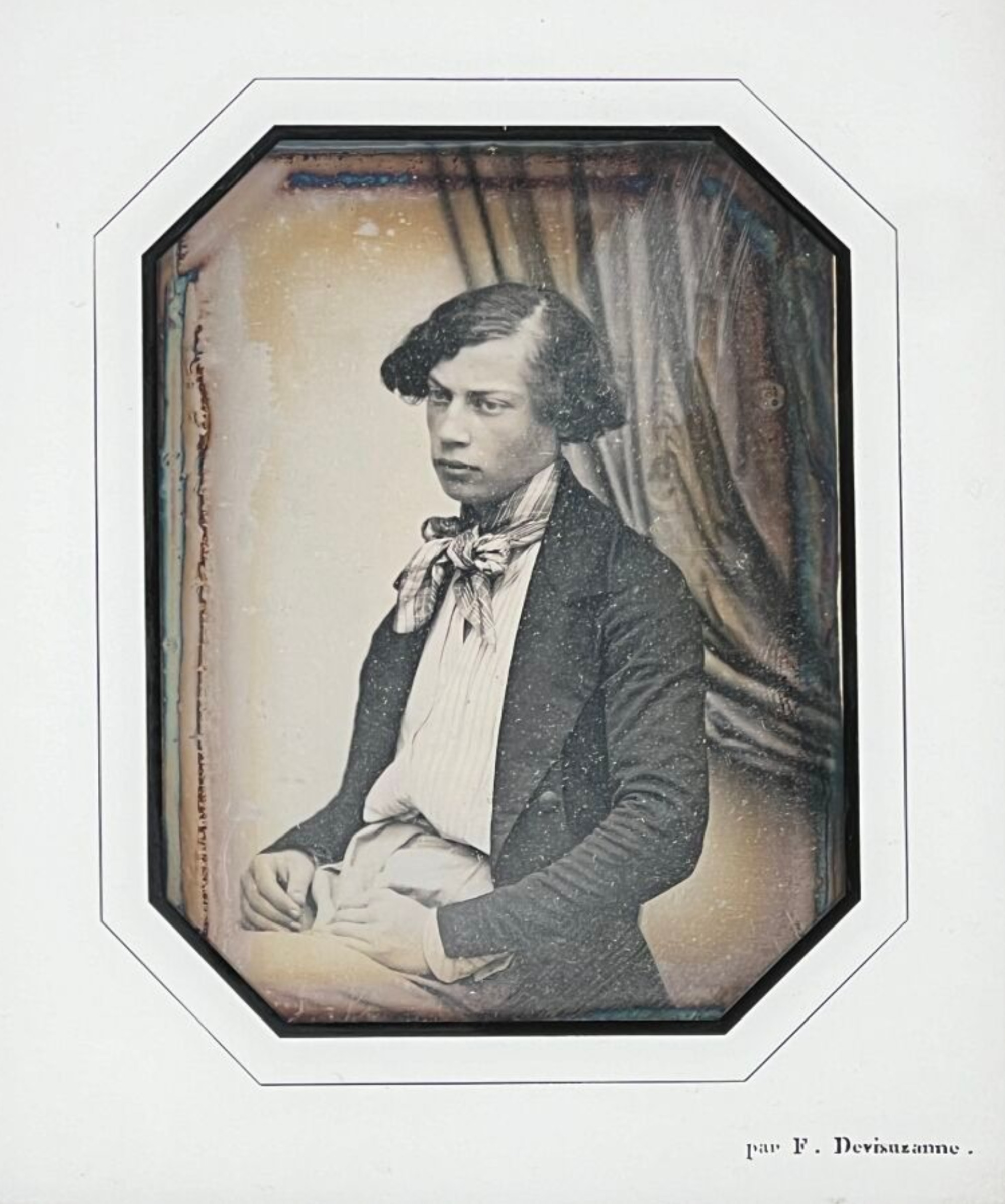

Avant La Dame aux camélias : un portrait au daguerréotype inédit d’Alexandre Dumas fils
Je me contente de raconter.
Alexandre Dumas fils
Ce daguerréotype quart de plaque représente Alexandre Dumas Fils jeune. Il est annoté au dos à l’encre noire : « Portrait d'Alexandre Dumas (fils). Aux environs de la 20eme année. Donné par lui à Joseph Autran », et signé sur le montage d'origine F. Devisuzanne. Cette épreuve inédite (9,8 x 7,4 cm) montre un jeune homme à l’attitude mélancolique, portraituré en buste de trois quarts. Alexandre Dumas est le fils du grand écrivain du même nom, l’auteur du Comte de Monte Christo. On devine encore avec nuance dans le visage du jeune homme les traits métissés qui lui viennent de son grand-père paternel, un général d’armée, lui-même fils d’une esclave noire, traits qui étaient plus prononcés chez son père.
Ce portrait photographique, contemporain de la publication du premier grand roman d’Alexandre Dumas père, Les Trois mousquetaires (1844), a été réalisé à Dieppe par Félix Devisuzanne (1809-1873), qui débute son activité dans la ville côtière normande à partir de l’été 1843.
On peut penser que le portrait a été réalisé entre l’été 1843 (installation du photographe à Dieppe) et le début de 1845 au plus tard (par la mention « aux alentours de 20 ans »). Si le cliché se place dans les premiers temps de cette fourchette temporelle, le portrait précède la rencontre de Dumas fils avec Marie Duplessis ; s’il est plus tardif, il est alors contemporain de leur liaison, qui dure de septembre 1844 à août 1845. Rappelons que La Dame aux camélias, le grand roman d’Alexandre Dumas fils, publié en 1848 et adapté sous forme de drame de 5 actes par l’auteur (1852), puis pour l’opéra par Verdi (La Traviata, 1853), s'inspire de faits réels. Sous les traits d’Armand Duval et de Marguerite Gautier, les deux principaux protagonistes du roman, se dissimulent en effet l'auteur, Alexandre Dumas fils et Marie Duplessis (1824-1847), à la vie brève, qui fut l'une des courtisanes romantiques les plus célèbres du Tout-Paris.
Belle épreuve photographique inédite d’Alexandre Dumas fils, réalisée autour de 1844, alors qu’il rédige ses premiers écrits. L’écrivain connaîtra une belle fortune littéraire ; sa Dame aux camélias sera subtilement pastiché par Marcel Proust dans A la recherche du temps perdu.
Before The Lady of the Camellias: An Unpublished Daguerreotype Portrait of Alexandre Dumas, Jr.
I'm just telling the story.
Alexandre Dumas, Jr.
This quarter-plate daguerreotype depicts the young Alexandre Dumas, Jr., in black ink. It is annotated on the back in black ink: "Portrait of Alexandre Dumas (Jr.). Around the age of 20. Given by him to Joseph Autran," and signed on the original mount F. Devisuzanne. This unpublished print (9.8 x 7.4 cm) shows a young man with a melancholic attitude, portrayed in a three-quarter bust view. Alexandre Dumas is the son of the great writer of the same name, author of The Count of Monte Cristo. The young man's face still reveals the nuanced mixed features inherited from his paternal grandfather, an army general, himself the son of a Black slave, features that were more pronounced in his father.
This photographic portrait, contemporary with the publication of Alexandre Dumas père's first major novel, The Three Musketeers (1844), was taken in Dieppe by Félix Devisuzanne (1809-1873), who began his career in the Normandy coastal town in the summer of 1843.
The portrait can be assumed to have been taken between the summer of 1843 (when the photographer moved to Dieppe) and at the latest by the beginning of 1845 (given the mention "around the age of 20"). If the photograph falls within the early part of this timeframe, the portrait predates Dumas fils's encounter with Marie Duplessis; If it is later, it is then contemporaneous with their affair, which lasted from September 1844 to August 1845. It should be remembered that La Dame aux camélias, the great novel by Alexandre Dumas fils, published in 1848 and adapted into a 5-act drama by the author (1852), then for the opera by Verdi (La Traviata, 1853), is inspired by true events. Under the guise of Armand Duval and Marguerite Gautier, the two main protagonists of the novel, are hidden the author, Alexandre Dumas fils and Marie Duplessis (1824-1847), who had a short life and was one of the most famous romantic courtesans of the Parisian elite.
Beautiful unpublished photographic print of Alexandre Dumas fils, taken around 1844, when he was writing his first works. The writer would go on to achieve great literary success; his Lady of the Camellias will be subtly pastiched by Marcel Proust in In Search of Lost Time.
Price on request

